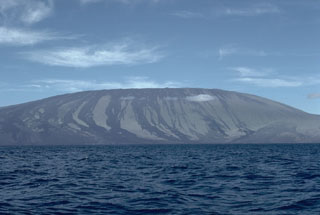Report on Wolf (Ecuador) — 12 January-18 January 2022
Smithsonian Institution / US Geological Survey
Weekly Volcanic Activity Report, 12 January-18 January 2022
Managing Editor: Sally Sennert.
Please cite this report as:
Global Volcanism Program, 2022. Report on Wolf (Ecuador) (Sennert, S, ed.). Weekly Volcanic Activity Report, 12 January-18 January 2022. Smithsonian Institution and US Geological Survey.
Wolf
Ecuador
0.02°N, 91.35°W; summit elev. 1710 m
All times are local (unless otherwise noted)
On 13 January IG reported that the eruption at Wolf was continuing, but at decreasing levels. Lava from at least three fissures had traveled about 16.5 km SE, and covered an estimated 7.4 square kilometers, but had not reached the coast. Daily counts of thermal anomalies were in the hundreds but had progressively decreased in quantity and intensity in recent days, interpreted as a decrease in the effusion rate and cooling flows. Notices of ash-and-gas plumes were issued by the Washington VAAC on 7-8 January, noting that plumes decreased from 2.6 km to 300 m above the vent. Additionally, sulfur dioxide emissions decreased from 60,000 tons per days recorded on 7 January to 8,100 tons per day on 12 January. Seismicity also trended downward.
Geological Summary. Volcán Wolf, the highest volcano of the Galápagos Islands, straddles the equator at the north end of the archipelago's largest island, Isabela. The edifice has steeper slopes than most other Isabela volcanoes, reaching angles up to 35°. The summit caldera is 6 x 7 km across and 700 m deep. A prominent bench on the west side of the caldera rises 450 m above the caldera floor, much of which is covered by a lava flow erupted in 1982. Radial fissures concentrated along diffuse rift zones extend down the N, NW, and SE flanks, and submarine vents lie beyond the N and NW fissures. Similar unvegetated flows originating from a circumferential chain of spatter and scoria cones on the eastern caldera rim drape the forested flanks to the sea. The proportion of aa lava flows exceeds that of other Galápagos volcanoes. An eruption in in 1797 was the first observed and documented in the Galápagos Islands.
Source: Instituto Geofísico-Escuela Politécnica Nacional (IG-EPN)

